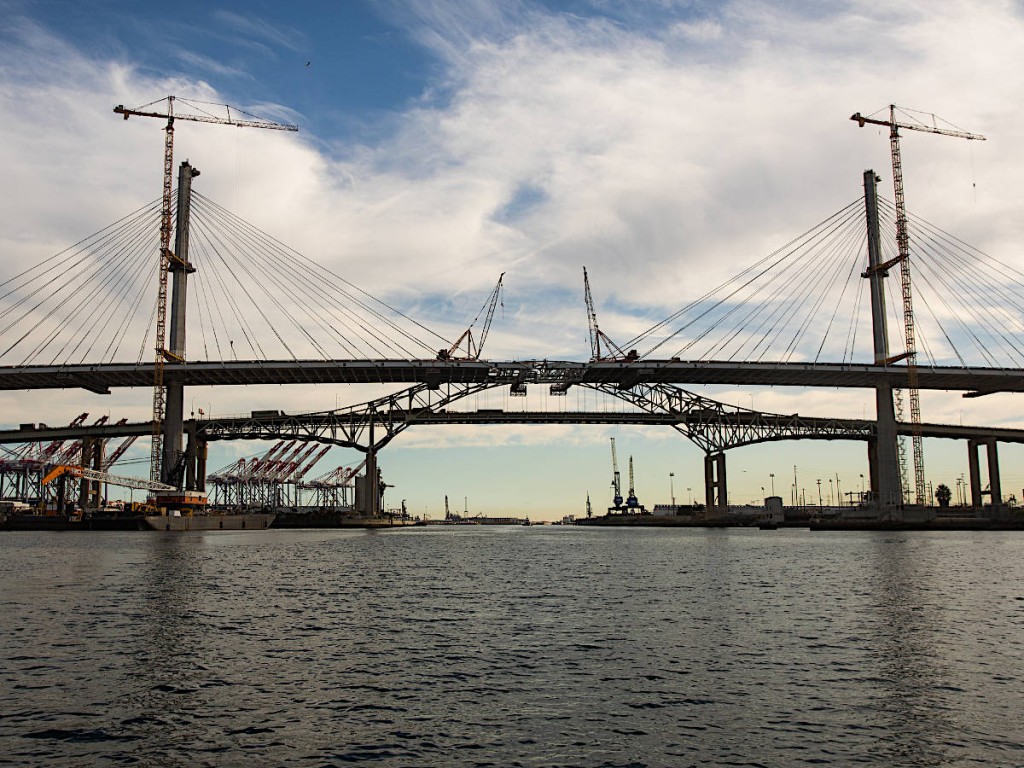Port of Long Beach’s New Desmond Replacement expected to open in August
The Port of Long Beach’s new bridge replacing the old Gerald Desmond is scheduled to be open for truck and commuter traffic by mid-August, according to a Port of Long Beach official.
Duane Kenagy, the Port of Long Beach’s capital projects executive, told AJOT that the new bridge will reduce steepness compared to the older bridge by 1% making it easier and faster for trucks to cross without slowing down: “The grade in the old bridge was 6%. The grade in the new bridge is 5%, which will make it easier for trucks to transit the structure without having to radically slow down and back up auto and truck traffic.”
The new bridge is a collaboration between the California Department of Transportation (Caltrans) and the Port of Long Beach, Kenagy added. In addition, the new bridge will be higher than the older bridge so that vessels of greater container capacity can pass under heading towards the inner harbor terminals: “The older bridge had the air draft that would allow a vessel of up to 9,000 TEUs to pass under it headed for the inner harbor. The taller replacement has an air draft that will allow 14,000 TEU ships to pass under its span.”
Kenagy noted that the bridge is projected to cost $1.47 billion and is part of a 10-year, $4 billion set of improvements enabling the Port of Long Beach to remain modern, competitive and big-ship ready.

The project includes funding contributions from the U.S. Department of Transportation and the Los Angeles County Metropolitan Transportation Authority (Metro).
In explaining the bridge’s new look Kenagy said, “The new bridge has a cable-stayed design, a first for California, and a 100-year lifespan. With 205 feet of clearance over the water, the new bridge will be high enough to accommodate larger cargo ships. It will be wider and better able to serve the approximately 68,000 vehicle trips that cross the current bridge each day.”
He said truckers and commuters should enjoy a faster and safer ride going between the ports of LA and Long Beach as a result of new safety features:
- Three lanes in each direction for improved traffic flow
- Emergency lanes on both sides to reduce traffic delays and safety hazards from accidents and vehicle breakdowns
In addition, Kenagy said, “The new bridge has several design improvements that make it safer, more efficient, and ultimately cheaper to build.” These improvements include:
Cable stayed design. Cable-stayed bridges differ from their suspension predecessors in that they don’t require anchorages, nor do they need two towers. Instead, the cables run from the roadway up to a single tower that alone bears the weight.
Design-Build. The Gerald Desmond Bridge Replacement Project is a “design-build” project that combines project design and construction into one contract, as opposed to the standard process done in three stages: design, bid, build. By being more efficient, design-build projects have the potential to be built faster and at a lower cost than traditional bridge construction projects.
Mobile scaffolding. One of the construction innovations was the mobile scaffolding which is designed for higher bridge structures. There were two mobile scaffolding systems and they were moved 50 times to facilitate the bridge construction.
Seismic dampers. Seismic dampers that act as shock absorbers are placed into the bridge structure to absorb the shock of an earthquake. The design used on the bridge was originally developed to protect the headquarters of the Strategic Air Command (SAC).
There are 75 seismic sensors in the structure which can pinpoint damage that the bridge might suffer in an earthquake.
On any given day 350 to 400 craft labor workers were employed in the co destruction of the bridge, Kenagy said. This included carpenters represented by the Carpenter’s Union and electrical workers, represented by the International Brotherhood of Electrical Workers. In addition, there was a range to 300 to 1,000 workers including architects, engineers and other support staff.
The cost of the bridge was budgeted at $1.47 billion dollars and has stayed within budget. This budget amount included $62 million dollars to demolish the old Gerald Desmond bridge.
Several finishing touches will still need to be made to the bridge including architectural lighting and surveillance cameras.
The bridge includes the Mark Bixby Memorial Bicycle-Pedestrian Path with scenic overlooks.
Similar Stories
SC Ports Weather Advisory for Jan. 23, 2025
Due to inclement weather, SC Port terminals in Charleston will be closed for motor carriers on Thursday, January 23, 2025. Inland Port Dillon and Inland Port Greer will operate under…
View Article
North Carolina Ports: Winter Weather Notice
View Article
Onne Multipurpose Terminal invests in new cranes
View Article
Wallenius Wilhelmsen celebrates the grand opening of its Brunswick terminal
View Article
SC Ports Weather Advisory Jan. 22, 2025
View Article
Stacking Cranes Market Outlook 2034
View ArticleGet the most up-to-date trending news!
SubscribeIndustry updates and weekly newsletter direct to your inbox!





